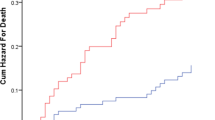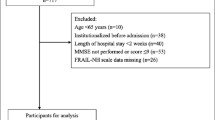Key summary points
To examine the predictive value of the Multidimensional Prognostic Index (MPI) on unplanned hospital readmission in geriatric patients.
AbstractSection FindingsFrail patients have higher risk of unplanned readmission compared to non-frail.
AbstractSection MessageThe aggregated MPI is superior to the prognostic value of every single domain in the tool according to the prediction of unplanned readmission.
Abstract
Purpose
Targeting health care interventions requires valid measurements when predicting unplanned hospital readmission. The Multidimensional Prognostic Index (MPI) based on Comprehensive Geriatric Assessment (CGA) enables the prediction of mortality and length of stay (LOS) in older hospitalized patients. Our aim was to validate if the MPI as a frailty tool could predict unplanned hospital readmission in geriatric patients.
Methods
This prognostic study was conducted in geriatric wards. The target population was 65 + -year-old patients hospitalized with acute illness. The MPI tool is derived from eight CGA domains by an interdisciplinary team: social aspects, number of drugs, activities of daily living (ADL), instrumental-ADL, cognitive status, severity of morbidity, risk of developing pressure sores, and nutritional status. Patients assessed were categorized into three groups: non-frail (MPI-1), moderate frail (MPI-2) or severe frail (MPI-3). Primary outcome was 30-day unplanned readmission and secondary LOS and 90-day mortality.
Results
In total 1467 patients were included from January 1, 2018, to October 1, 2019. Mean age was 84.2 years (± 7.4) and 59% were women. 15.7% were readmitted. Hazard ratio (HR) for readmission in the MPI-2 group (n = 635) was 2.57; 95% confidence interval (CI) 1.25–5.29 (p = 0.01), and 2.60; 95% CI 1.27–5.33 (p = 0.009) in the MPI-3 group (n = 711) compared to the MPI-1 group (n = 121). MPI was a predictor of LOS and mortality.
Conclusion
Using the MPI tool to identify the frail and non-frail patients is applicable to predict unplanned hospital readmission in geriatric patients. The MPI is superior to the prognostic value of each single domain. MPI will be of great value to health professionals’ decision-making.


Similar content being viewed by others
References
Clegg A, Young J, Iliffe S, Rikkert MO, Rockwood K (2013) Frailty in elderly people. Lancet 381(9868):752–762
Pedersen MK, Meyer G, Uhrenfeldt L (2017) Risk factors for acute care hospital readmission in older persons in Western countries: a systematic review. JBI Database Syst Rev Implement Rep 15(2):454–485
Garcia-Perez L, Linertova R, Lorenzo-Riera A, Vazquez-Diaz JR, Duque-Gonzalez B, Sarria-Santamera A (2011) Risk factors for hospital readmissions in elderly patients: a systematic review. QJM 104(8):639–651
Verloo H, Goulet C, Morin D, von Gunten A (2016) Association between frailty and delirium in older adult patients discharged from hospital. Clin Interv Aging 11:55–63
Stillman GR, Stillman AN, Beecher MS (2019) Frailty is associated with early hospital readmission in older medical patients. J Appl Gerontol. https://doi.org/10.1177/0733464819894926
Pedersen LH, Gregersen M, Barat I, Damsgaard EM (2016) Early geriatric follow-up after discharge reduces readmission—a quasi-randomised controlled trial. Eur Geriatr Med 7:443–448
Hao Q, Zhou L, Dong B, Yang M, Dong B, Weil Y (2019) The role of frailty in predicting mortality and readmission in older adults in acute care wards: a prospective study. Sci Rep 9(1):1207
Kahlon S, Pederson J, Majumdar SR, Belga S, Lau D, Fradette M et al (2015) Association between frailty and 30-day outcomes after discharge from hospital. CMAJ 187(11):799–804
Joosten E, Demuynck M, Detroyer E, Milisen K (2014) Prevalence of frailty and its ability to predict in hospital delirium, falls, and 6-month mortality in hospitalized older patients. BMC Geriatr 14:1
Volpato S, Bazzano S, Fontana A, Ferrucci L, Pilotto A (2015) Multidimensional Prognostic Index predicts mortality and length of stay during hospitalization in the older patients: a multicenter prospective study. J Gerontol A Biol Sci Med Sci 70(3):325–331
Caplan GA, Williams AJ, Daly B, Abraham K (2004) A randomized, controlled trial of comprehensive geriatric assessment and multidisciplinary intervention after discharge of elderly from the emergency department—the DEED II study. J Am Geriatr Soc 52(9):1417–1423
Fried LP, Tangen CM, Walston J, Newman AB, Hirsch C, Gottdiener J et al (2001) Frailty in older adults: evidence for a phenotype. J Gerontol A Biol Sci Med Sci 56(3):M146–M156
Rockwood K, Mitnitski A (2007) Frailty in relation to the accumulation of deficits. J Gerontol Ser A Biol Sci Med Sci 62(7):722–727
Pilotto A, Ferrucci L, Franceschi M, D'Ambrosio LP, Scarcelli C, Cascavilla L et al (2008) Development and validation of a multidimensional prognostic index for 1-year mortality from comprehensive geriatric assessment in hospitalized older patients. Rejuvenation Res 11(1):151–161
Ellis G, Whitehead MA, O'Neill D, Langhorne P, Robinson D (2011) Comprehensive geriatric assessment for older adults admitted to hospital. Cochrane Database Syst Rev 7:CD006211
Warnier RMJ, van Rossum E, van Velthuijsen E, Mulder WJ, Schols JMGA, Kempen GIJM (2016) Validity, reliability and feasibility of tools to identify frail older patients in inpatient hospital care: a systematic review. J Nutr Health Aging 20(2):218–230
Harris PA, Taylor R, Thielke R, Payne J, Gonzalez N, Conde JG (2009) Research electronic data capture (REDCap)—a metadata-driven methodology and workflow process for providing translational research informatics support. J Biomed Inform 42(2):377–381
Sundhedsstyrelsen. Monitorering & Medicinsk Teknologivurdering. Genindlæggelser af ældre i Danmark 2008. København: Sundhedsstyrelsen; 2009.
Moons KG, Altman DG, Reitsma JB, Ioannidis JP, Macaskill P, Steyerberg EW et al (2015) Transparent Reporting of a multivariable prediction model for Individual Prognosis or Diagnosis (TRIPOD): explanation and elaboration. Ann Intern Med 162(1):W1–73
Katz S, Downs TD, Cash HR, Grotz RC (1970) Progress in development of the index of ADL. Gerontologist 10(1):20–30
Lawton MP, Brody EM (1969) Assessment of older people: self-maintaining and instrumental activities of daily living. Gerontologist 9(3):179–186
Zuckerman JD, Koval KJ, Aharonoff GB, Skovron ML (2000) A functional recovery score for elderly hip fracture patients: II. Validity and reliability. J Orthop Trauma 14(1):26–30
Pfeiffer E (1975) A short portable mental status questionnaire for the assessment of organic brain deficit in elderly patients. J Am Geriatr Soc 23(10):433–441
Conwell Y, Forbes NT, Cox C, Caine ED (1993) Validation of a measure of physical illness burden at autopsy: the cumulative illness rating scale. J Am Geriatr Soc 41(1):38–41
Vellas B, Guigoz Y, Garry PJ, Nourhashemi F, Bennahum D, Lauque S et al (1999) The mini nutritional assessment (MNA) and its use in grading the nutritional state of elderly patients. Nutrition 15(2):116–122
Sancarlo D, D'Onofrio G, Franceschi M, Scarcelli C, Niro V, Addante F et al (2011) Validation of a modified-multidimensional prognostic index (m-MPI) including the mini nutritional assessment short-form (MNA-SF) for the prediction of one-year mortality in hospitalized elderly patients. J Nutr Health Aging 15(3):169–173
Bliss MR, McLaren R, Exton-Smith AN (1966) Mattresses for preventing pressure sores in geriatric patients. Mon Bull Minist Health Public Health Lab Serv 25:238–268
Fischer JE, Bachmann LM, Jaeschke R (2003) A readers' guide to the interpretation of diagnostic test properties: clinical example of sepsis. Intensive Care Med 29(7):1043–1051
Pilotto A, Veronese N, Daragjati J, Cruz-Jentoft AJ, Polidori MC, Mattace-Raso F et al (2019) Using the multidimensional prognostic index to predict clinical outcomes of hospitalized older persons: a prospective, multicenter, international study. J Gerontol A Biol Sci Med Sci 74(10):1643–1649
Kansagara D, Englander H, Salanitro A, Kagen D, Theobald C, Freeman M et al (2011) Risk prediction models for hospital readmission: a systematic review. J Am Med Assoc 306(15):1688–1698
Pilotto A, Sancarlo D, Pellegrini F, Rengo F, Marchionni N, Volpato S et al (2016) The multidimensional prognostic index predicts in-hospital length of stay in older patients: a multicentre prospective study. Age Ageing 45(1):90–96
Angleman SB, Santoni G, Pilotto A, Fratiglioni L, Welmer AK, MPI_AGE Project Investigators (2015) Multidimensional prognostic index in association with future mortality and number of hospital days in a population-based sample of older adults: results of the EU Funded MPI_AGE Project. PLoS One 10(7):e0133789
Pilotto A, Dini S, Daragjati J, Miolo M, Mion MM, Fontana A et al (2018) Combined use of the multidimensional prognostic index (MPI) and procalcitonin serum levels in predicting 1-month mortality risk in older patients hospitalized with community-acquired pneumonia (CAP): a prospective study. Aging Clin Exp Res 30(2):193–197
Volpato S, Daragjati J, Simonato M, Fontana A, Ferrucci L, Pilotto A (2016) Change in the multidimensional prognostic index score during hospitalization in older patients. Rejuvenation Res 19(3):244–251
De Luca E, Perissinotto E, Fabris L, Pengo V, Zurlo A, De Toni P et al (2015) Short- and longer-term predictive capacity of the multidimensional prognostic index: the timing of the assessment is of no consequence. Arch Gerontol Geriatr 61(3):458–463
Ryg J, Engberg H, Mariadas P, Pedersen SGH, Jorgensen MG, Vinding KL et al (2018) Barthel Index at hospital admission is associated with mortality in geriatric patients: a Danish nationwide population-based cohort study. Clin Epidemiol 10:1789–1800
Acknowledgements
The authors would like to thank the patients for their invaluable contributions and the staff in the Department of Geriatrics for their outstanding participation in this study and their tireless and profound work in assessing all the patients. The study was funded by “MVU-puljen” from Aarhus University Hospital, Denmark.
Author information
Authors and Affiliations
Contributions
The first author MG was the project manager, conducted the statistical analyses, and wrote the drafts. TKH and BBJ contributed to the interpretation of data and critically revised the manuscript. EMD contributed to the conception of the work, the interpretation of data, and final approval of the version to be published.
Corresponding author
Ethics declarations
Conflict of interest
On behalf of all authors, the corresponding author states that there is no conflict of interest.
Ethical approval
The study was conducted according to the principles of the Declaration of Helsinki and registered at the Danish Data Protection Agency (No. 1-16-02-28-17).
Informed consent
Since the MPI screening is routinely part of the geriatric assessment in the clinic of the Department of Geriatrics, neither consent from the patients nor approval by The Central Denmark Region Ethical Committee was required.
Additional information
Publisher's Note
Springer Nature remains neutral with regard to jurisdictional claims in published maps and institutional affiliations.
Electronic supplementary material
Below is the link to the electronic supplementary material.
Rights and permissions
About this article
Cite this article
Gregersen, M., Hansen, T.K., Jørgensen, B.B. et al. Frailty is associated with hospital readmission in geriatric patients: a prognostic study. Eur Geriatr Med 11, 783–792 (2020). https://doi.org/10.1007/s41999-020-00335-w
Received:
Accepted:
Published:
Issue Date:
DOI: https://doi.org/10.1007/s41999-020-00335-w




